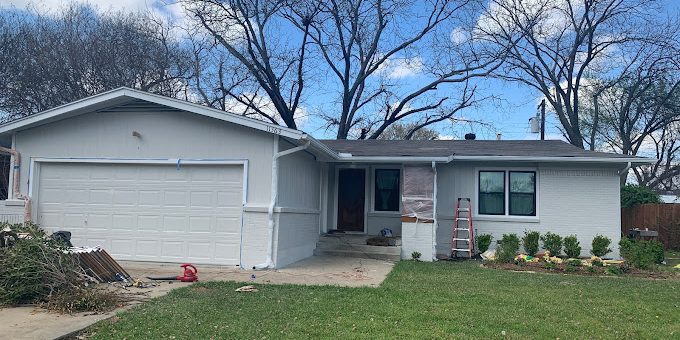When it comes to exterior painting, ensuring the weather is right is key to a successful and long-lasting finish. Whether you’re looking to refresh your home’s curb appeal in Allen, Texas, or complete a large-scale commercial exterior painting project, the right conditions can make all the difference. Poor weather can negatively affect the quality of your paint job, leading to premature wear, cracking, or peeling.
Key Takeaway: The best weather conditions for exterior painting are moderate temperatures with low humidity and no rain. When conditions are ideal, the paint dries properly, adheres well, and lasts longer.
Ideal Temperature Range for Exterior Painting
The temperature plays a crucial role in the success of your exterior painting project. Ideally, the temperature should be between 50°F and 85°F (10°C to 29°C) for optimal paint application. In Allen, Texas, temperatures often fluctuate, especially during the summer and winter months, so it’s essential to plan accordingly.
When painting in too hot weather, the paint can dry too quickly, which leads to visible brush marks, bubbling, or cracking. This is because the surface dries faster than the paint can be applied. Conversely, in cooler weather, the paint may not dry properly, which can result in a streaky finish or prolonged drying times. If you’re not sure whether the temperature is suitable, it’s a good idea to consult with professionals in exterior house painting, like the team at MJ Workforce Solutions, who can guide you through the ideal conditions for your specific project.
Humidity’s Impact on Exterior Painting
Humidity is another critical factor to consider when planning your painting project. When the air is too humid, the moisture can prevent the paint from adhering to the surface properly, leading to poor results and a less durable finish. The ideal humidity level for exterior painting should be between 40% and 70%. In Allen, TX, the humidity can often rise, particularly in the warmer months, so it’s vital to check the weather forecast to avoid painting on high-humidity days.
On humid days, the paint takes longer to dry, which may cause it to smudge or become uneven. This can be particularly problematic for residential painting projects where aesthetics are key. If you are unsure about the humidity levels or how they will impact your project, you can always rely on the expertise of professional painting companies to ensure a flawless outcome.
Wind Conditions for Safe Exterior Painting
Wind can have a significant effect on how the paint is applied to the surface. In windy conditions, the paint may dry too quickly, leading to an uneven finish. Additionally, dust, dirt, and debris may blow onto your freshly painted surface, which can ruin the overall look and feel of your project. Ideally, you should avoid painting on days with gusty winds or during stormy weather in Allen, TX. A light breeze is acceptable, but high winds can make the job difficult and cause the paint to splatter or dry too fast.
Finding the Right Time to Paint in Allen, TX
Understanding the weather conditions in your area is key to planning your exterior painting project. In Allen, Texas, the most optimal months tend to be in the spring and fall when temperatures are more moderate, and there is less humidity. By scheduling your project during these months, you ensure the conditions are favorable for a successful paint job.
For more insights on planning a painting project, check out our Exterior Painting Services for Allen, TX.
The Role of Precipitation in Painting Success
Rain is one of the biggest threats to any exterior painting project. If it starts raining before the paint has dried properly, it can wash away or dilute the paint, ruining the job completely. It’s important to ensure the weather forecast predicts no rain for at least 24 hours after painting. The paint must be allowed to cure in dry conditions to form a strong bond with the surface.
When painting in areas prone to sudden showers or fluctuating weather, it’s advisable to work with professionals who can monitor the weather for you. This helps to avoid wasted time and effort if the weather conditions turn unfavorable.
Special Considerations for Winter and Summer
Summer in Allen, TX, can get quite hot, making it a tricky time to tackle an exterior painting project. Painting during the hottest part of the day can cause the paint to dry too fast, resulting in poor application and the need for multiple touch-ups. However, during early mornings or late afternoons, the conditions tend to be more favorable for painting.
Winter months may also be challenging. While the cooler temperatures can be helpful, freezing temperatures pose a threat to the drying process. It’s essential to avoid painting when the temperature is near or below freezing, as this can interfere with the adhesion and drying process of the paint. For those considering exterior painting in colder weather, it’s recommended to work with an experienced team of exterior painting contractors who understand the ins and outs of painting in diverse weather conditions.
What Can You Do to Mitigate Weather Effects?
While you can’t control the weather, there are several strategies you can employ to ensure a successful exterior paint job:
- Proper Timing: Wait for the right weather conditions to align before starting your project. If you’re unsure when that is, it may be beneficial to hire professionals who have extensive experience working with the Texas climate.
- Choose the Right Paint: Some paints are formulated for use in higher temperatures or more humid conditions. Choosing the right product can mitigate the challenges presented by unpredictable weather.
- Protection Measures: If it looks like it may rain or the humidity levels are high, you can protect your freshly painted surfaces with tarps or covers. These can shield the paint from moisture until it fully dries.
Common Questions About Weather and Exterior Painting
How do I know if the weather is right for painting?
The best way to determine if the weather is right is to check for moderate temperatures (between 50°F and 85°F), low humidity, and clear skies. If you’re unsure, you can always consult with a professional painting company for guidance.
Can I paint my house in the winter?
It’s best to avoid painting in freezing conditions, as this can interfere with the drying and curing process. However, a mild winter day (above 35°F) might be suitable for exterior painting, depending on the paint type.
How long should I wait after painting before it rains?
You should wait at least 24 hours after applying paint before it rains. This ensures that the paint has had enough time to dry and cure.
Weathering the Storm: Plan for Success
It’s clear that weather conditions are one of the most significant factors that impact the quality and longevity of your exterior painting project. From temperature to humidity, wind, and precipitation, every aspect of the weather needs to be considered before you begin.
When planning your next exterior painting project, it’s a great idea to partner with a reliable and experienced team of professional painters who understand local weather patterns and can ensure your project is completed successfully, no matter the forecast.
Reach Out to MJ Workforce Solutions for Expert Help
If you’re ready to give your home or commercial property a fresh new look, don’t hesitate to contact MJ Workforce Solutions for top-quality painting services. Whether you’re looking for interior painting, cabinet painting, or exterior painting in Allen, TX, we’re here to help. Let us guide you through the best conditions for a perfect paint job and deliver results that last.







